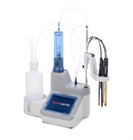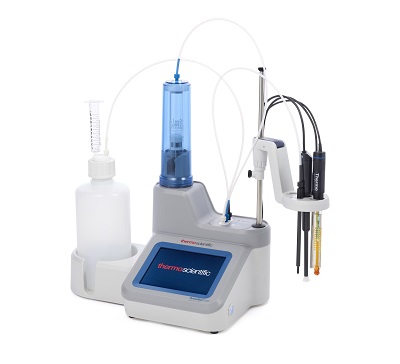Featured Article

Most scientists started out titrating by hand—patiently adding drops to a sample and watching for a color change to indicate a transition. Then, a few calculations indicated the concentration of a target substance in the sample. But that’s not needed today. Although titration by hand remains a valuable learning tool, platforms on the market make this technique easier to do and more accurate. In addition, titration platforms often provide scientists with more than one way to test a solution.
For example, a potentiometric titrator relies on a chemical reaction to determine the concentration of a targeted substance in a sample. A Karl Fischer (KF) titrator measures the amount of water in a sample, which is a useful measurement for products from many industries, such as foods and pharmaceuticals. The KF technique uses volumetry or coulometry, which are best for 1–100 or 0.01–10 milligrams of water, respectively. As with many forms of instrumentation, the applications of titration determine the best technology to seek in a platform, as well as the required sample sizes. Some titrators also provide automation, which can be handy in some cases and invaluable in others.
As a Thermo Fisher Scientific (Waltham, MA) website notes: “Manual titrations are time consuming and can be inaccurate at times due to human error. Not to mention, important data can get easily lost due to improper tracking methods.” This reveals the general value of replacing manual titration with an instrument-based method.
Regardless of how titration is done, many industries need it. As mentioned, titration is used in the food and pharmaceutical industries, as well as environmental testing, petrochemicals, and more.
Advances available
Moving from the teaching-lab approach with a dropper and patience, anything seems easier, but some of today’s platforms focus on making steps simpler still. When asked about the latest advance in titrators from Thermo Fisher Scientific, Sean Carey—product director, water analysis and lab products—points out the “easy-to-use navigation from setup to live titration analysis to data transfer.” Carey adds, “Our titrator has a modern, professional look with a high-resolution 5.7” color touchscreen display that showcases instructions, help menus, and titrations for improved viewing and operation.”
 To get the most accurate titrations, scientists can use a variety of platforms, such as Thermo Fisher Scientific’s Orion Star T940. (Image courtesy of Thermo Fisher Scientific.)
To get the most accurate titrations, scientists can use a variety of platforms, such as Thermo Fisher Scientific’s Orion Star T940. (Image courtesy of Thermo Fisher Scientific.)The titrators from Thermo Fisher Scientific also include other features that improve the operation and outcomes. “To ensure accurate, reproducible, and reliable results when using an automated titrator, our titrators have a high-accuracy burette and dispenser system that offers 25,600 microsteps per motor revolution, 2 million microsteps over the full burette stroke range,” Carey notes.
It’s not just the hardware that determines the complexity of using a titrator, but also the software. As Carey explains, “Our Titration Setup Wizard walks users through setup steps for performing a sample titration—ideal for lab technicians transitioning from manual to automated titrations.”
In addition, Thermo Fisher Scientific and other vendors build titrators that can store methods. “Our titrators save up to 10 methods, plus offer the ability to back up important methods and share among titrators using a USB flash drive—ideal for frequent, routine titrations of similar samples that require minor method changes and larger laboratories with multiple titrators,” Carey says.
Beyond running samples, scientists need a titrator that keeps track of the results. For Thermo Fisher titrators, Carey says, “To view and preserve critical analysis results, our titrators save up to 100 titration datasets with date/time stamp and facilitate data transfer to printer, computer, or USB drive.”
Setup shopping
The titrator market includes platforms made for various users. For example, Metrohm (Riverview, FL) developed its Titrando line for professional use, describing these KF-based platforms as “developed to meet exacting titration demands.” As the company notes: “These titrators come with a wide range of security and traceability options, making them particularly suitable for use in regulated industries.” For example, the Titrando titrators maintain an audit trail that provides full regulatory traceability, plus compliance on many levels: U.S. Food and Drug Administration 21 CFR Part 11, plus meeting good lab and manufacturing practices (GLP and GMP, respectively).
Making a platform fit a specific need often determines the one to buy. With Metrohm’s Titrando titrators, accessories make these platforms ready to run custom processes, based on the addition of dosing devices, stirrers, and so on. The software that comes with these platforms can be used to set up specific processes and even run automated methods. In fact, Metrohm points out that these platforms “can either be used as standalone titrators or integrated into an overarching network.”
From Mettler Toledo (Columbus, OH), the Explore EasyPlus runs a variety of methods, including working like a potentiometer or KF titrator. According to the company, this titrator “offers a complete package for your routine application.” Plus, the platform is very easy to use. “Operation does not get simpler or more intuitive [than] this, thanks to the smartphone like iTitrate user interface and iTitrate intelligence,” the company states. The platform can also run in an automatic mode.
Some platforms get as automatic as possible, and one example is the Metrohm 855 Robotic Titrosampler. The company describes this product as “the world’s first combined automated titrator. It has all the capabilities of the 809 Titrando titrator in the body of an 815 Robotic Sample Processor.” So, in one platform, this provides the capabilities of a Titrando titrator and automation. Despite those features, Metrohm calls this platform compact. It can also be controlled with a PC through a plug-and-play USB connection.
Plug-and-play is not exactly how it felt when I titrated by hand years ago. In fact, I figured that I’d only titrate that way, and there’s still good reason to do so, but mostly just when learning or if the method is used too rarely in a lab to justify a dedicated platform. Where titration gets used often, though, an instrument makes a huge difference in the process and getting the right outcome. Before jumping into a purchase, however, think about how a titrator will be used and who will use it. Those bits of information take a scientist a long way in purchasing the best titrator platform for a lab.
Mike May is a freelance writer and editor living in Texas. He can be reached at [email protected]